
Dirk Slawinski
enjoying the posted "ocean" questions
Favourite Thing: Figure things out, nothing makes me feel better than figuring out why something works … or in most cases of late, why they do not work! But that is the fun part, not everything works as you expect it to. I do a broad range of work, from computer modelling, to habitat map making, to designing underwater video systems so there is always something different for me to do.
My CV
School:
Raymond High School [1982-1986] (Raymond, New Hampshire ,USA), Higgins Junior High School (Peabody, Massachusetts, USA) [1980-1982], Center School [1974-1980] (Peabody, Massachusetts, USA)
University:
[1998] Unversity of Minnesota (USA) Masters in Geology and Geophysics; [1992] University of New Hampshire (USA) Bachler of Science in Earth Sciences; [1988] New Hampshire Technical Institute (USA) Associates Degree in Computer Engineering Technology
Work History:
CSIRO (current); Centre for Water Research, University of Western Australia; Department of Geology and Geophysics, University of Minnesota; Fugro McClelland East, Portsmouth NH, USA; Complex Systems Research Center, University of New Hampshire
Employer:
CSIRO Marine and Atmospheric Research, in Floreat (Perth) Western Australia.
Current Job:
Data Analyst/Programmer (jack of all trades, master of none)
Me and my work
I mainly work with ocean models, “feeding” them data, analysing the results and making plots to help understand the results.
My background is in earth science and computer programming and so I have a broad range of skills. This means the kinds of projects I work on can be quite broad too.
- A small but “fun” project I am part of (and am quite proud of) is called POTBot, or Pictures Of The Bottom. These little computer controlled cameras sit inside the bait basket of a Crayfish (Western Rock Lobster) pot/trap. They record the immediate area around the pots so the WA Department of Fisheries can map more readily the habitats were the rock lobsters live. As a side benefit we also get an idea of the types of fish that frequent those areas.
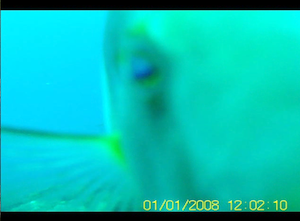
Here is a video of the kind of things a POTBot sees: http://www.youtu.be/ze9Vxvxinh0
- One major group of projects I am working on at the moment involve using computer models that describe how the ocean currents off the Western Australian coast work. We use these models to move around virtual fish and lobster larvae to see where they go after they hatch. These “physical models” help the biologists think about how larvae would behave under different conditions. They then tell us what those behaviors could be. We then add these “biological models” into the physical ones to get a more realistic description of the early life cycles.
- Things like development and over fishing can heavily impact areas that act as nurseries for many marine species. We also use these models to identify were eggs and larvae are likely to stick around and settle. This helps managers decide on which part of the coast are in more need of protection.
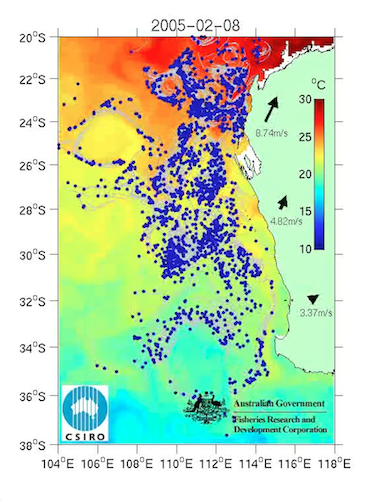
Here is a video of the kind of results one would see: http://youtu.be/ZFg84EeV5hQ
- I also do a fair bit map making for various projects I am on. These can range from habitat maps to maps of areas where likely “something” will happen. Below is an example of a simplified habitat map for Rottnest Island, Western Australia.

My Typical Day
Get up; take kids to school; spend morning handling emails, data requests and data collection/downloads; have lunch (with my wife if she has time); start some model runs and then plot data for an artistic high note before going home.
On a “typical” day the family gets up between 6:00 to 7:oo AM. My wife leaves before 7:00 for work and I get our two kids (they are 5 and 9) ready for school which as you know can take quite some time.
After the school drop-off I go to work getting in around 9:00.
In the morning I usually deal with the many emails that came in overnight. I also handle any data requests that came in. These can either be my “boss” requesting climate/ocean data from overseas sources or our research partners requesting model results/analyses.
Often I can do some model analyses, plots or map making in before lunch.
If my wife has time, she works in CSIRO as a scientist as well, we have lunch together around noon.
The afternoons usually revolve around doing model to real world comparisons. Also I set up any models that need to be run overnight or longer. This usually means I make sure all the needed data is available and in the format that the particular ocean model(s) need.
Then at 5:oo I head home and have dinner with my wife and kids and then help with clean up.
Around 7:30 we all get ready for bed and my wife and I sort out who reads to who. If all goes well we finish bedtime reading around 8:30. After that we relax with a nice show/movie or do some work we needed to finish during the day but did not get to.
What I'd do with the money
I would buy some updated parts to make a modified POTBot for a realtime-webstreaming underwater video system.
I would use the money to make a special POTBot.
I’ve always wanted to have one that could send its video (and the other data it collects) over the web so that students like yourselves could see fish/lobsters/etc in real time or near real time. There are several components I could add or replace in an existing POTBot which could do that. And there are several that I would need to adapt. These are all still relatively inexpensive and with the addition of a smartphone/iphone as a remote could make the POTBot more interactive (change view angle and so forth).
The POTBot would be moored in a marine park and I have one at Rottnest Island in mind that has a some interesting populations. There is also access to mobile phone towers which is a requirement as well as other infrastructure.
The idea of POTBot is to keep costs down and the $1000.o0 is a good goal post.
As there generally is no money for these sort of trials in the projects I am part of the $1000.00 would help me design and set up a proof of concept system that may attract money for a formal system later.
My Interview
How would you describe yourself in 3 words?
A bit odd
Who is your favourite singer or band?
Must I pick one? I have a very broad taste in music from Classical and Jazz to ’80s/’90s indie music (The Smiths, The Cure, They May Be Giants, etc) to techo/trance/nightcore and Hardstyle to Miku Hatsune (vocaloids).
What is the most fun thing you've done?
That depends on your idea of fun, but for me it would have been going mountain climbing in New Hampshire with friends.
If you had 3 wishes for yourself what would they be? - be honest!
1) to become anything I want and still maintain my intelligence 2) to never have to worry about money 3) have a never ending supply of LEGOs
What did you want to be after you left school?
A marine biologist … although I ended up a geologist/computer programmer (who now works with marine biologist funny how things work out in the end)
Were you ever in trouble in at school?
Not really, I was a bit of a goody two shoes … or perhaps just too clever to get caught … I’ll never tell =;P
What's the best thing you've done as a scientist?
Fun wise it would be a toss up between working on POTBot and being a Scientist in Schools for my kids school, but work wise it would be being a co-authur on a paper in Nature [http://www.nature.com/nature/journal/v400/n6743/abs/400437a0.html].
Tell us a joke.
How do you catch a unique rabbit? Unique up on it!
Sports followed
Sadly none … I’m a bit of geek that way. I used to like hockey, the proper ice kind, but moving to Australia sort of cured that.
Favourite team
My profile link:
https://lithium.imascientist.org.au/profile/dirkslawinski/
 Print this profile
Print this profile

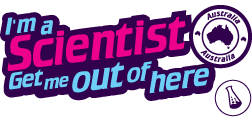

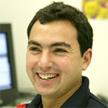
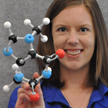

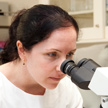




 Print this profile
Print this profile